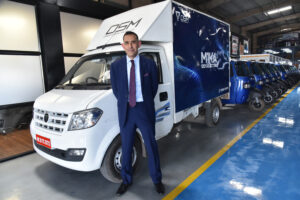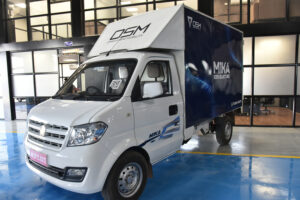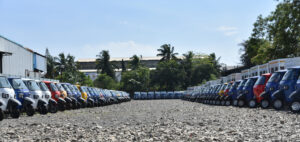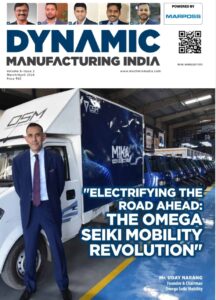“An Exclusive Insight into Mr. Uday Narang’s Vision, Innovation, and Leadership in the Electric Vehicle Frontier”
Omega Seiki Mobility Journey
Q. Mr. Narang, could you share with us the inspiration behind the founding of Omega Seiki Mobility and take us through the journey of the company so far?
A. Seven years ago, my relocation to India was driven by a profound concern for environmental challenges, particularly the escalating pollution levels and adverse climate conditions. This realization, coupled with a deep-seated love for my country, ignited the founding vision of Omega Seiki Mobility. Having spent three decades as a hedge fund manager in the USA and the UK, my transition to entrepreneurship in a vastly different market posed formidable challenges. However, driven by unwavering determination, we charted a remarkable trajectory, securing the 3rd position in the industry within a mere 2-3 years.
Our commitment to innovation was pivotal, considering our nascent presence in the Original Equipment Manufacturer (OEM) landscape. We meticulously addressed every facet of the automotive domain, spanning two-wheelers for cargo and passengers, three-wheelers for cargo and passengers, electric trucks, and even drones. The comprehensive approach enabled us to establish a formidable presence across diverse vehicle segments.
From riding in Teslas, to being the “Tesla of the East,” there is a resolute determination to continue our upward trajectory with an unwavering focus on excellence and innovation.
Q. What inspired your entry into the electric mobility sector, and what valuable insights have you gained from your experiences in this industry?
A. The decision to venture into the electric mobility sector was rooted in a dual motivation – a commitment to environmental sustainability and a genuine desire to contribute to India’s future. Observing the escalating challenges of pollution and climate impact, combined with a profound love for the nation, drove the establishment of Omega Seiki Mobility.
Our experiences in the electric mobility industry have provided crucial insights pivotal to our journey. Notably, in navigating the dynamic landscape of technology and consumer preferences, innovation and adaptability stand as non-negotiable elements. In a price-sensitive market like India, we meticulously calibrated our products and pricing to meet the demands of the discerning consumer, ensuring that our offerings are competitive and compelling.
As a new player amidst formidable names entering the electric vehicle (EV) industry, we recognized the imperative to be the best in terms of specifications to gain a foothold in the dynamic Indian market. This realization underscored our commitment to delivering top-notch products that stand out in terms of performance, efficiency, and value.
Being the Chairman of the Anglian Omega Group played a pivotal role, leveraging our global connections to navigate the complexities of the industry. The benefits of being a fully integrated company cannot be overstated – our significant ties with major companies in technology and innovation have positioned us as a formidable player. Moving forward, we are dedicated to expanding these ties, leaving no stone unturned in our pursuit of cutting-edge technology and innovation.
In essence, our journey in the electric mobility sector is characterized by a strategic blend of innovation, adaptability, market acumen, and collaborative efforts, all aimed at delivering superior products and contributing to the evolution of sustainable transportation solutions in India.

Product and offerings
Q. Could you provide insights into the range of vehicles offered by Omega Seiki and elaborate on the various offerings available?
A. At Omega Seiki, our commitment to revolutionizing the electric vehicle industry is reflected in our comprehensive range of innovative and sustainable vehicles. We take pride in offering a diverse portfolio that caters to the varied mobility needs of our customers.
Our lineup includes electric two and three-wheelers designed for both cargo and passenger applications. This versatility is a testament to our dedication to meeting the diverse demands of our broad customer base. What sets our vehicles apart is the incorporation of cutting-edge technologies, ensuring efficiency and convenience in every journey.
One of the key features of our electric vehicles is the flexibility in battery options. Customers can choose from fixed batteries, 15-minute fast charging, and our groundbreaking battery swap technology. This reflects our commitment to providing adaptable solutions that align with the evolving needs of our clientele.
At Omega Seiki, we pride ourselves on being industry trailblazers. Our track record includes introducing pioneering initiatives such as the first green hydrogen-powered three-wheeler. We also stand out for designing the first three-wheeler specifically for cold chain logistics, showcasing our forward-thinking approach to addressing diverse industry needs.
We have achieved significant milestones, including launching the longest-range three-wheeler in India, boasting an impressive 250-kilometer range. These achievements underscore our dedication to pushing the boundaries of electric vehicle capabilities and setting new benchmarks in the market.
In the passenger electric three-wheeler segment, we offer two distinct models: Stream and Stream City. Stream, designed for rural areas, is a spacious 3+1 three-wheeler, while Stream City caters to urban environments with its compact design, ensuring optimal maneuverability and efficiency.

Our commitment to holistic solutions is further evident in our range of two-wheelers, serving both cargo and passenger needs. These electric two-wheelers showcase our dedication to providing sustainable mobility options across diverse segments.
Industry and Market
Q. In the dynamic landscape of electric mobility, what opportunities do you see for Omega Seiki Mobility, and how do you stay ahead in this competitive market?
A. In the dynamic landscape of electric mobility, Omega Seiki Mobility is strategically positioned to seize numerous opportunities and maintain a competitive edge in the evolving market. Our commitment extends to various key focus areas that contribute to our comprehensive approach to navigating this transformative industry.
Firstly, we recognize the critical role of Tier 2, 3, and 4 cities in driving widespread electric vehicle adoption. As part of our strategy, we are dedicated to enhancing EV accessibility in these regions, tailoring our initiatives to address the unique challenges and requirements of each location.
Furthermore, acknowledging the paramount need for a robust charging infrastructure nationwide, Omega Seiki Mobility is actively involved in initiatives aimed at enhancing charging facilities. Our goal is to ensure that users across all regions have convenient access to charging, thereby eliminating a significant barrier to EV adoption.
Anticipating emerging trends in the EV industry, we are positioning ourselves to incorporate elevated safety standards and design aesthetics into our vehicle offerings. This forward-thinking approach aligns with our commitment to staying ahead and meeting evolving consumer expectations.
Additionally, with swift advancements expected in fast charging technologies, we are proactively positioning ourselves to integrate these innovations into our products. The potential reduction in charging times to as brief as 5 minutes aligns with our overarching goal to enhance the convenience and efficiency of EVs for our customers.
We also foresee a paradigm shift towards the diversification of EV utilization across industries, ranging from logistics and food to transportation and automotive sectors. Our product portfolio is designed to cater to this evolving demand, reflecting our commitment to versatility in EV applications.
Recognizing the pivotal role of the Total Cost of Ownership (TCO) model in influencing EV adoption, Omega Seiki Mobility is dedicated to providing transparency in cost considerations. Our focus on comprehensive costs aligns with the needs of businesses and consumers, facilitating informed decision-making in the adoption of electric vehicles.
Embracing the confluence of design, technology, AI, and robotics, we are at the forefront of driving innovation across the EV ecosystem. Our aspirations for 2024 include empowering women in the EV workforce, emphasizing “Nari Shakti” (women’s empowerment) for gender inclusivity and diversity.
Q. How does Omega Seiki Mobility navigate challenges in the electric vehicle sector, and what strategies have you employed to ensure the company’s success?
A. In navigating the challenges of the electric vehicle sector, Omega Seiki Mobility adopts a proactive and strategic approach, leveraging key insights and lessons from past experiences to ensure the company’s success. In both 2023 and anticipations for 2024, the company has confronted and addressed challenges head-on through innovative solutions and a commitment to industry growth.
Challenges in 2024:
The foremost challenge anticipated in 2024 revolves around the imperative of charging infrastructure. Omega Seiki Mobility recognizes the need for comprehensive facilities nationwide, encompassing fixed, fast, swap, and innovative charging solutions. To facilitate widespread electric vehicle adoption, the company is actively involved in developing robust charging infrastructure initiatives. By addressing this challenge, Omega Seiki Mobility aims to eliminate a critical barrier to EV adoption and enhance the overall user experience.
Another significant challenge identified is the need for a coherent and enduring government strategy. Omega Seiki Mobility emphasizes the importance of sustained policy development for industry growth, stability, and predictability in the regulatory landscape. The company advocates for a strategic and continuously evolving policy framework that provides clarity and stability in the rapidly evolving landscape of electric vehicle adoption.
In summary, Omega Seiki Mobility’s strategy for overcoming the challenges of 2024 involves not only establishing a robust charging infrastructure but also actively engaging with policymakers to contribute to the development of a consistent and forward-looking regulatory environment.
Challenges faced in 2023:
In 2023, the electric vehicle sector encountered significant challenges, primarily driven by the introduction of AI 156-I and AI 156-II standards addressing battery fire concerns. Despite contributing to global advancements in battery safety, these standards led to delays and confusion, hindering the progress of electric vehicles in the country. Additionally, the implementation of FAME 1 added further complexity, introducing uncertainties that restrained the industry’s growth trajectory.
Omega Seiki Mobility navigated these challenges with resilience and dedication, recognizing the importance of adapting to evolving standards and regulatory frameworks. The company focused on overcoming supply chain challenges and actively contributing to shaping the industry during its formative stages.
As the industry transitions into 2024, Omega Seiki Mobility is optimistic about improvements in supply chain issues. The challenges faced in 2023 have served as valuable lessons, shaping the company’s strategies and contributing to the establishment of a cleaner and greener automotive landscape in India.
Innovation and Technology
Q. Mr. Narang, could you highlight some of the innovative technologies that set Omega Seiki Mobility’s electric vehicles apart from others?
A. At Omega Seiki Mobility, our commitment to innovation is reflected in the distinctive technologies that set our electric vehicles apart from others in the competitive market. One of our key features is the offering of multi-battery options, allowing customers to choose from fixed batteries, 15-minute fast charging, and revolutionary battery swap technology. This flexibility empowers users to select the charging solution that aligns best with their preferences and requirements, emphasizing our commitment to providing adaptable and user-friendly electric vehicles.
A notable milestone for Omega Seiki Mobility is the introduction of a green hydrogen-powered three-wheeler, showcasing our dedication to sustainable and eco-friendly solutions. This innovative approach not only highlights our commitment to pushing the boundaries of green technology but also positions us as pioneers in integrating alternative and clean energy sources into our vehicle line-up.
We take pride in being the first company to launch the longest-range three-wheeler in India, boasting an impressive range of 250 kilometres. This achievement underscores our commitment to pushing the limits of electric vehicle capabilities and providing our customers with an extended and reliable range, addressing one of the key concerns in EV adoption.
Omega Seiki Mobility also addresses specialized market needs with the introduction of the first three-wheeler designed specifically for cold chain logistics. This strategic move showcases our industry foresight and commitment to developing vehicles tailored to unique transportation requirements, further enhancing the versatility of our electric vehicle offerings.
In the passenger electric three-wheeler segment, our lineup includes Stream and Stream City, catering to rural and urban areas, respectively. These vehicles not only offer spacious and compact options but also incorporate innovative design features, contributing to a comfortable and efficient commuting experience for passengers.
Our foray into the two-wheeler segment extends our innovative approach to electric mobility, offering options for both cargo and passenger transport. These electric two-wheelers combine versatility and sustainability, providing efficient solutions for various mobility requirements and further solidifying our position as a comprehensive player in the electric vehicle market.
Beyond vehicle technology, Omega Seiki Mobility places a strategic focus on the Total Cost of Ownership (TCO) model. Recognizing the significance of comprehensive costs in influencing EV adoption, our commitment to transparency in cost considerations aligns with the needs of businesses and consumers, fostering informed decision-making.
Q. How do you, as a leader, secure Omega Seiki Mobility’s position at the forefront of technological advancements in the electric vehicle domain?
A. My approach to securing our position at the forefront of technological advancements in the electric vehicle (EV) domain is rooted in innovation, strategic planning, and a commitment to excellence. Several key strategies contribute to maintaining our leadership in this dynamic industry:
Research and Development (R&D) Investment:
I prioritize substantial investments in research and development, ensuring that Omega Seiki Mobility remains at the cutting edge of EV technology. By allocating resources to R&D, we foster a culture of innovation within the organization, allowing us to anticipate industry trends and stay ahead of the technological curve.
Cross-Functional Collaboration:
I foster a collaborative environment that encourages cross-functional collaboration within the company. By facilitating communication and idea-sharing among different teams – from engineering and design to marketing and sales – we ensure that diverse perspectives contribute to the development of innovative solutions.
Strategic Partnerships and Alliances:
Building strategic partnerships and alliances with key players in the tech and automotive industries is crucial. These collaborations enable us to access cutting-edge technologies, share insights, and collectively push the boundaries of what is possible in the electric vehicle space.
Agile Development and Adaptability:
I instill an agile development mindset within the organization, emphasizing adaptability and responsiveness to market changes. This allows us to quickly incorporate emerging technologies into our products, responding effectively to shifts in consumer preferences and industry advancements.
Continuous Learning and Skill Development:
Prioritizing continuous learning and skill development for our workforce is essential. I encourage ongoing training programs to keep our team abreast of the latest technological developments and industry best practices, ensuring that we have the expertise required to implement cutting-edge solutions.
Customer Feedback and Market Analysis:
Regularly gathering customer feedback and conducting thorough market analysis allows us to understand evolving consumer needs and preferences. This customer-centric approach guides our innovation efforts, ensuring that our technological advancements align with real-world demands and expectations.
Sustainability Integration:
Recognizing the growing importance of sustainability, I emphasize the integration of eco-friendly technologies into our electric vehicles. This includes exploring advancements in battery technology, energy efficiency, and alternative energy sources to contribute to a cleaner and greener automotive landscape.
Participation in Industry Events and Forums:
Actively participating in industry events, forums, and conferences allows us to stay connected with the latest trends and breakthroughs in the electric vehicle domain. It also provides opportunities to showcase our innovations, build networks, and collaborate with other leaders in the field.
Strategic Vision and Future Planning:
I maintain a forward-thinking strategic vision for Omega Seiki Mobility, encompassing long-term planning and anticipating future trends. By aligning our objectives with the evolving landscape of electric mobility, we position the company to not only adapt to change but also lead in shaping the future of the industry.
In summary, my leadership approach focuses on a combination of innovation, collaboration, adaptability, and a commitment to sustainability. By implementing these strategies, Omega Seiki Mobility is well-positioned to secure and maintain its position at the forefront of technological advancements in the electric vehicle domain.
Challenges and Solutions:
Q. Every business faces challenges. Can you discuss some challenges Omega Seiki Mobility has encountered and the strategies you’ve employed to overcome them?
A. In navigating the challenges of the electric vehicle sector, Omega Seiki Mobility adopts a proactive and strategic approach, leveraging key insights and lessons from past experiences to ensure the company’s success. In both 2023 and anticipations for 2024, the company has confronted and addressed challenges head-on through innovative solutions and a commitment to industry growth.
Challenges in 2024:
The foremost challenge anticipated in 2024 revolves around the imperative of charging infrastructure. Omega Seiki Mobility recognizes the need for comprehensive facilities nationwide, encompassing fixed, fast, swap, and innovative charging solutions. To facilitate widespread electric vehicle adoption, the company is actively involved in developing robust charging infrastructure initiatives. By addressing this challenge, Omega Seiki Mobility aims to eliminate a critical barrier to EV adoption and enhance the overall user experience.
Another significant challenge identified is the need for a coherent and enduring government strategy. Omega Seiki Mobility emphasizes the importance of sustained policy development for industry growth, stability, and predictability in the regulatory landscape. The company advocates for a strategic and continuously evolving policy framework that provides clarity and stability in the rapidly evolving landscape of electric vehicle adoption.
In summary, Omega Seiki Mobility’s strategy for overcoming the challenges of 2024 involves not only establishing a robust charging infrastructure but also actively engaging with policymakers to contribute to the development of a consistent and forward-looking regulatory environment.
Challenges faced in 2023:
In 2023, the electric vehicle sector encountered significant challenges, primarily driven by the introduction of AI 156-I and AI 156-II standards addressing battery fire concerns. Despite contributing to global advancements in battery safety, these standards led to delays and confusion, hindering the progress of electric vehicles in the country. Additionally, the implementation of FAME 1 added further complexity, introducing uncertainties that restrained the industry’s growth trajectory.
Omega Seiki Mobility navigated these challenges with resilience and dedication, recognizing the importance of adapting to evolving standards and regulatory frameworks. The company focused on overcoming supply chain challenges and actively contributing to shaping the industry during its formative stages.
As the industry transitions into 2024, Omega Seiki Mobility is optimistic about improvements in supply chain issues. The challenges faced in 2023 have served as valuable lessons, shaping the company’s strategies and contributing to the establishment of a cleaner and greener automotive landscape in India.

Q. Addressing concerns like range anxiety and charging infrastructure is crucial. How does Omega Seiki Mobility tackle these issues in the electric vehicle market?
A. Addressing concerns such as range anxiety and limited charging infrastructure is a pivotal focus for Omega Seiki Mobility (OSM), as we strive to advance the electric vehicle (EV) market in India. Recognizing the importance of a comprehensive charging network, we employ a multi-faceted approach to tackle these issues and ensure the widespread adoption of electric mobility.
One significant initiative that underscores our commitment to nurturing EV infrastructure is the installation of our first EV charger at the campus of Indira Gandhi Delhi Technical Universities for Women in New Delhi through OSM e-link. This serves as a tangible example of our dedication to fostering the growth of EV infrastructure, especially in educational institutions, and sets the stage for similar installations in the future.

In our collaborations, particularly with partners involved in battery technology and related fields, we prioritize infrastructure development. Our partnerships explicitly include commitments from our collaborators to actively participate in building the necessary charging infrastructure. Encouragingly, these collaborative efforts have yielded impressive progress, with the number of charging stations increasing from 150 to approximately 300 in a short period.
To further contribute to charging infrastructure development, OSM actively engages in partnerships with charging station providers. These collaborations play a crucial role in expanding the network of charging stations across various locations. Importantly, our strategic focus extends beyond metropolitan areas to Tier 2, 3, and 4 cities. Recognizing the vital role these cities play in overall accessibility and the success of electric mobility, we are dedicated to making sustainable transportation options readily available to diverse urban landscapes in India.
Our approach also emphasizes the facilitation of ease of charging for our customers. By actively participating in the development and expansion of the charging infrastructure, we aim to provide convenient and accessible charging options for EV users. This holistic strategy aligns with our vision to contribute to the creation of a robust and supportive ecosystem for electric mobility in India, addressing concerns related to range anxiety and limited charging infrastructure.
Manufacturing and the Supply Chain
Q. From your perspective and experience, do we have the right and adequate manufacturing ecosystem in the country in terms of a robust supplier ecosystem, skilled manpower availability, and physical infrastructure for the EV industry to meet the fast-growing local and international demand for the EVs? What are the other factors needed in place for a faster growth?
A. From my perspective and experience, the electric vehicle (EV) manufacturing ecosystem in India is indeed on a growth trajectory, driven by government support, an established auto industry, and a rising demand for EVs. However, several factors need attention to ensure that the industry can meet the fast-growing local and international demand effectively.
In terms of current strengths, government initiatives such as the Faster Adoption and Manufacturing of Hybrid and Electric Vehicles (FAME-II) and the Production-Linked Incentive (PLI) schemes have played a crucial role in attracting investments and fostering domestic manufacturing. Additionally, India’s well-established auto industry provides a strong foundation for the transition to electric vehicles, leveraging a skilled workforce capable of adapting to the nuances of EV production. The growing demand for electric two-wheelers and three-wheelers within the country further signals a positive shift towards sustainable mobility.
However, there are areas that require improvement to sustain and accelerate this growth. The dependence on imports for critical components like Lithium-ion battery cells stands out as a significant challenge. This not only increases costs but also limits the overall production capacity of electric vehicles. Strengthening the local supplier ecosystem is crucial for fostering a self-reliant and competitive EV industry. Moreover, while there is a skilled workforce in place, specialized training in EV technology at all levels is necessary to meet the evolving demands of the industry.
The availability of an extensive charging infrastructure is another critical aspect that needs attention. Addressing range anxiety and encouraging widespread EV adoption require a robust network of charging stations. Investing in and expanding the charging infrastructure will significantly contribute to the growth of the sector and instill confidence in potential EV users.
Looking at other factors for faster growth, a focus on indigenous battery manufacturing, including the production of battery cells and not just assembly, is vital. This strategic move would not only reduce costs but also ensure a secure supply chain for critical components. Continued investment in research and development (R&D) remains essential for developing cost-effective EV models and efficient battery management systems. Innovation will be a key driver in staying competitive in the rapidly evolving global EV market.
Creating dedicated EV manufacturing zones, with streamlined clearances and access to resources, emerges as a practical solution for expediting growth. Specialized zones can provide a conducive environment for manufacturers to scale up operations efficiently and drive the technological advancements needed for a flourishing EV industry.
In conclusion, while India has made significant strides in the EV manufacturing sector, addressing challenges related to the supplier ecosystem, workforce skills, charging infrastructure, and focusing on innovative solutions will be instrumental in achieving faster growth. The country has the potential to emerge as a major player in the global EV market, and strategic interventions can further propel this industry toward success.
Q. Since the battery technology is central to the EV strategy, do we have the adequate infrastructure and trade network that can support battery production. To what extent do we depend on the international markets for components and raw material procurement? What measures could the govt and the industry take to improve procurement and production?
A. In the current landscape of India’s electric vehicle (EV) ecosystem, the state of battery technology plays a pivotal role in shaping the industry’s trajectory. However, there are notable challenges related to infrastructure, trade dependencies, and raw material procurement that need to be addressed to establish a robust and self-sufficient battery production ecosystem.
As of now, the infrastructure for battery production in India is somewhat limited. While the country has established capabilities in producing lead-acid batteries for traditional vehicles, the focus on large-scale lithium-ion cell production is still in the early stages. Efforts are underway to set up giga factories for lithium-ion cells, but substantial progress is required to meet the growing demand for electric vehicles.
A significant concern is the heavy reliance on international markets for critical battery components such as cathodes, anodes, and electrolytes. This dependence not only increases costs for manufacturers but also limits control over the supply chain, making the industry vulnerable to global price fluctuations and supply disruptions. Streamlining the import processes and developing strategic partnerships for raw material procurement are crucial steps to address trade network limitations.
To improve the current scenario, both the government and the industry can take measures to enhance battery production in India.
Government Initiatives:
Production Incentives: Introducing production-linked incentives (PLI) specifically for cell manufacturing, encompassing cathode and anode materials, would attract investments and accelerate domestic production.
Skill Development and Research: Investing in skill development programs focused on battery technology and encouraging research in indigenous battery materials and cell development are essential for fostering long-term growth and innovation.
Trade Agreements: Negotiating trade agreements with countries rich in lithium and other battery minerals can secure reliable and cost-effective sources for raw materials.
Industry Contributions:
Collaboration: Collaboration between established players, startups, and research institutions can foster innovation and accelerate the development of cost-effective and efficient battery technologies.
Vertical Integration: Companies venturing into cell manufacturing can explore establishing partnerships with mining companies or setting up their own raw material procurement channels. This step would reduce dependence on international imports.
Recycling Infrastructure: Developing a robust battery recycling infrastructure is critical for responsible waste management, recovery of valuable materials, and reducing reliance on virgin resources. This holistic approach contributes to the sustainability of the battery production ecosystem.
By implementing these measures, India can move towards a more self-reliant and sustainable battery production ecosystem, ultimately strengthening its EV industry and aligning with its clean energy goals. These initiatives would not only improve the domestic supply chain but also contribute to the global efforts in building a more sustainable and resilient electric vehicle market.
The Charging Infrastructure
Q. The EV charging infrastructure is key to a country’s EV adoption curve. India’s charging infrastructure at 12146 public EV charging stations (PCS) has some distance to go to meet, say, China’s (1.8 million public charging points), and Germany’s (100,000) infrastructure . One reason, of course, is the comparatively lower EV sales as a percentage of total vehicle sales in the country. What are the other main reasons behind our country’s sparse charging station density? What are top measures that the industry and the government can adopt to boost and expand the country’s EV charging infrastructure.
A. India’s EV charging infrastructure requires significant development to facilitate widespread electric vehicle adoption. Several factors contribute to the sparse charging station density, including economic considerations, lack of strategic planning, limited land availability, slow bureaucratic processes, and low consumer awareness.
Economically, setting up charging stations, particularly fast chargers, demands substantial capital investment. The lower EV user base in the country makes profitability uncertain, discouraging private companies from large-scale deployment. Additionally, haphazard placement of charging stations without strategic planning, considering factors like traffic patterns and user needs, diminishes their overall effectiveness.
Challenges such as limited land availability, particularly in urban areas, and slow bureaucratic processes for obtaining permits and approvals further hinder the rapid deployment of charging infrastructure. Moreover, low consumer awareness about EVs and the advantages of charging infrastructure creates a challenging situation, contributing to the slower adoption rate.
To address these challenges and boost the charging infrastructure, collaborative efforts between the government and the industry are essential. The government can play a pivotal role by providing subsidies and tax breaks to companies setting up charging stations, streamlining land allotment processes, and expediting approvals. Mandating charging infrastructure in public spaces like parking lots, malls, and government buildings can create a more readily available and accessible network.
Furthermore, the government should focus on standardization and regulations, setting clear standards for charging equipment and protocols to ensure compatibility and encourage innovation. Public-private partnerships (PPPs) can leverage expertise, share risks, and accelerate infrastructure development. A balanced approach involving both slow and fast chargers, strategically placed for overnight charging at homes and workplaces and quick charging in public locations, caters to diverse user needs.
Innovative solutions, such as mobile charging vans, battery swapping stations, and rooftop solar-powered chargers, should be explored to expand reach and convenience. Collaborative efforts within the industry to conduct public awareness campaigns can educate consumers about EVs and highlight the benefits of charging infrastructure.
By implementing these measures collaboratively, India can bridge the gap in its EV charging network, addressing range anxiety and creating a more robust and sustainable EV ecosystem in the country.
India’s EV market and the Future
Q: India’s EV market has many interesting characteristics. The biggest one is that the fastest growing sectors in terms of adoption (also referred to as market penetration) are the 2-wheelers and 3-wheeler segments, not so much the 4-wheeler passenger and commercial segments (source: The EV reporter). Which also means that the big traditional automotive OEMs do not dominate this market, as they do the ICE market. What are the top reasons/factors that shape this peculiar trend of the 2W and 3W segments leading other segments in adoption, with the 4W being the slowest one to catch up.
A. India’s EV market exhibits a distinctive trend with 2-wheelers (2W) and 3-wheelers (3W) leading the adoption race, while the 4-wheeler (4W) segments lag behind. Several factors contribute to this peculiar trend.
Factors Favoring 2W & 3W EV Adoption:
Lower Upfront Cost: Electric scooters and rickshaws are considerably more affordable than electric cars. This lower upfront cost makes them accessible to a broader range of consumers, particularly those who prioritize budget-friendly options.
Government Incentives: Government policies and incentives, such as subsidies and the Faster Adoption and Manufacturing of Hybrid and Electric Vehicles (FAME-II) program, are primarily directed towards promoting 2W and 3W EV adoption. These policies enhance affordability, further propelling their market penetration.
Operational Cost Benefits: The operational cost advantages of electric 2W and 3W, stemming from lower running costs due to electricity compared to traditional fuels, make them economically attractive. This is particularly relevant for commercial use, such as delivery services.
Shorter Charging Range Needs: 2W and 3W vehicles typically have smaller driving range requirements compared to 4Ws. This aligns well with the current limitations of the charging infrastructure, reducing “range anxiety” for users.
Existing Ecosystem: India already has a well-established network of manufacturers, service centers, and spare part suppliers for 2W and 3W vehicles. Leveraging this existing ecosystem facilitates a smoother transition to electric options in these segments.
Challenges for 4W EV Adoption:
Higher Upfront Cost: Electric cars still command a significantly higher upfront cost compared to their internal combustion engine (ICE) counterparts. This limits affordability and makes them less accessible to a wider consumer base.
Limited Model Availability: The availability of electric car models in the Indian market is more restricted compared to the diverse options in the 2W and 3W segments. Limited model choices impact consumer preferences and adoption rates.
Range Anxiety: Concerns about the limited driving range of electric cars, especially for long-distance travel, contribute to “range anxiety” among potential buyers. This perception impedes the adoption of 4W EVs.
Higher Battery Replacement Cost: The substantial cost of replacing electric car batteries is a deterrent for prospective buyers. This factor significantly impacts the long-term ownership considerations for 4W EVs.
Charging Infrastructure Challenges: The sparse availability of fast-charging infrastructure, particularly on highways, makes long-distance travel in electric cars impractical for many consumers.
In summary, the affordability, operational benefits, and an existing ecosystem make 2W and 3W EVs more compelling for the Indian market at this stage. However, as technology advances, costs decrease, and the charging infrastructure expands, it is anticipated that 4W EV adoption will gradually catch up. Collaborative efforts from the industry and government in addressing these challenges will play a crucial role in accelerating the adoption of electric vehicles across all segments.
Environment Sustainability: The EV Impact
Q. The biggest attraction of the EVs is its transformational impact on the environment. Its large-scale adoption in India, which unfortunately has some of the world’s most polluting cities, will significantly reduce the carbon footprint of the transportation sector locally and globally. Could you share with our readers the topmost factors that make EV so much environmentally efficient, and how its adoption could not only reduce vehicular pollution, but also make the energy sector overall more sustainable?
A. Electric Vehicles (EVs) indeed offer a transformative impact on the environment, making them a crucial component in addressing the challenges of vehicular pollution and contributing to overall sustainability. Several factors make EVs more environmentally efficient:
Zero Emissions at Point of Use: One of the primary advantages of EVs is that they produce zero tailpipe emissions. Unlike traditional internal combustion engine vehicles that release pollutants directly into the air, EVs contribute to cleaner and healthier air quality in urban environments.
Reduced Greenhouse Gas Emissions: EVs significantly reduce the carbon footprint associated with transportation. The shift from fossil fuel-powered vehicles to electric ones results in lower greenhouse gas emissions, helping combat climate change. This is particularly pertinent in regions with high pollution levels, such as some of the world’s most polluted cities in India.
Energy Efficiency: EVs are generally more energy-efficient than traditional vehicles. They convert a higher percentage of electrical energy from the grid to power at the wheels, leading to lower overall energy consumption. This efficiency contributes to a more sustainable energy sector.
Promotion of Renewable Energy Integration: The adoption of EVs provides an opportunity to integrate renewable energy sources into the power grid. Charging infrastructure powered by renewable energy, such as solar or wind, enhances the sustainability of the entire energy ecosystem.
Reduced Noise Pollution: Electric vehicles operate more quietly than traditional vehicles, reducing noise pollution in urban areas. This improvement in acoustic environment positively impacts both human health and the overall quality of life.
Lifecycle Emissions: While EVs may have higher manufacturing emissions, their lower operational emissions over the vehicle’s lifecycle compensate for this. As the energy sector continues to transition toward renewable sources, the overall lifecycle emissions of EVs are expected to decrease further.
At Omega Seiki Mobility, we take pride in contributing to this environmental transformation. Through our electric mobility solutions, we have saved 5.90 Lakh Tons of CO2, equivalent to planting 32.2 Crore Trees. This showcases our commitment to sustainability and emphasizes the tangible impact that the widespread adoption of EVs can have on reducing vehicular pollution and making the energy sector more sustainable. As the industry progresses, such initiatives play a vital role in shaping a cleaner and greener future for transportation.
Final Reflections
Q. Mr. Narang, is there any additional information you’d like to convey regarding Omega Seiki Mobility or your perspective on the future of electric mobility?
A. Omega Seiki Mobility (OSM) is poised for significant growth and has outlined ambitious plans, marking a pivotal period in our journey towards sustainable mobility. Here are the key highlights of our growth strategy:
Expansion of Electric Three-Wheeler Offerings:
We are strategically expanding our electric three-wheeler portfolio, with a particular focus on the passenger segment. This expansion aligns with the increasing demand for eco-friendly urban mobility solutions. OSM aims to play a central role in shaping the future of urban transportation by providing sustainable and efficient electric three-wheelers.
Indigenization of Electric Trucks:
OSM is committed to indigenizing its electric trucks, emphasizing competitive pricing compared to existing market players. This commitment underscores our dedication to delivering cost-effective and sustainable electric vehicles. The upcoming launch of these electric trucks for business-to-consumer (B2C) markets is a significant step in this direction.
Establishment of a Manufacturing Unit for Electric Trucks:
To support the growing demand for electric trucks, OSM is planning to establish a dedicated manufacturing unit. This facility will contribute to meeting the increased requirements in the electric mobility sector, further reinforcing our commitment to manufacturing excellence and sustainability.
Launch of Muse – Air-Conditioned Passenger Electric Three-Wheeler:
Innovation remains at the forefront of OSM’s agenda, with the active development of Muse, an air-conditioned passenger electric three-wheeler. Muse aims to elevate the commuting experience by combining the efficiency of electric propulsion with the comfort of air-conditioned travel. This initiative underscores our commitment to offering solutions that prioritize both passenger comfort and environmental sustainability.
Introduction of Electric Two-Wheelers – Luce:
OSM is diversifying its product lineup with the introduction of electric two-wheelers, including the upcoming launch of Luce. This expansion into the electric two-wheeler segment allows us to cater to a broader consumer base and address the evolving demands in the electric mobility landscape.
Leadership in the Electric Mobility Revolution:
At OSM, our overarching vision is to be a leader in the electric mobility revolution. Our growth plans are strategically designed to meet dynamic market needs, contribute to a greener future, and position OSM as a key player in the evolving landscape of sustainable transportation.
In summary, OSM’s growth plans encompass a strategic expansion of our electric vehicle portfolio, indigenization of electric trucks, establishment of a dedicated manufacturing unit, and the introduction of innovative and passenger-focused vehicles. These initiatives reflect our proactive approach and influence in the transition towards sustainable and eco-friendly mobility solutions.
Do Visit – Omega seiki Mobility








